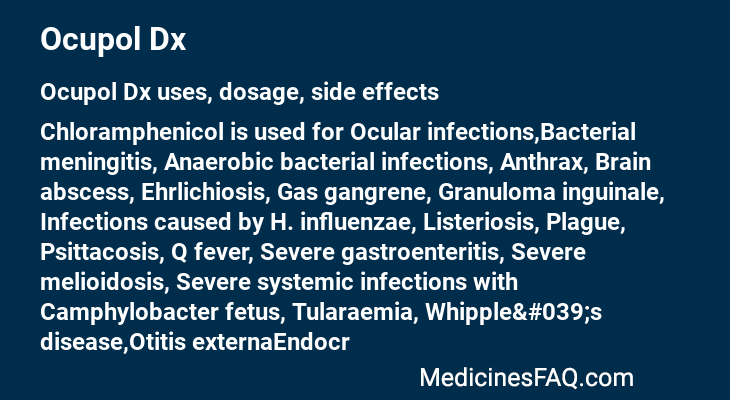Ocupol Dx
Ocupol Dx Uses, Dosage, Side Effects, Food Interaction and all others data.
Chloramphenicol inhibits bacterial protein synthesis by binding to 50s subunit of the bacterial ribosome, thus preventing peptide bond formation by peptidyl transferase. It has both bacteriostatic and bactericidal action against H. influenzae, N. meningitidis and S. pneumoniae.
Chloramphenicol is a broad-spectrum antibiotic that was derived from the bacterium Streptomyces venezuelae and is now produced synthetically. Chloramphenicol is effective against a wide variety of microorganisms, but due to serious side-effects (e.g., damage to the bone marrow, including aplastic anemia) in humans, it is usually reserved for the treatment of serious and life-threatening infections (e.g., typhoid fever). Chloramphenicol is bacteriostatic but may be bactericidal in high concentrations or when used against highly susceptible organisms. Chloramphenicol stops bacterial growth by binding to the bacterial ribosome (blocking peptidyl transferase) and inhibiting protein synthesis.
Dexamethasone is a synthetic glucocorticoid which decreases inflammation by inhibiting the migration of leukocytes and reversal of increased capillary permeability. It suppresses normal immune response.
Corticosteroids bind to the glucocorticoid receptor, inhibiting pro-inflammatory signals, and promoting anti-inflammatory signals. Dexamethasone's duration of action varies depending on the route. Corticosteroids have a wide therapeutic window as patients may require doses that are multiples of what the body naturally produces. Patients taking corticosteroids should be counselled regarding the risk of hypothalamic-pituitary-adrenal axis suppression and increased susceptibility to infections.
Polymyxin B Sulfate is the Sulfate salt of Polymyxins B1 & B2, which are produced by the growth of Bacillus polymyxa. Polymyxin B Sulfate has a bactericidal action against almost all Gram negative bacilli. Polymyxins increase the permeability of the bacterial cell membrane leading to death of the cell.
Polymyxin B is an antibiotic that disrupts the outer cell membrane of Gram negative bacteria, binds and neutralizes lipopolysaccharide, and inhibits respiration of Gram-negative bacterial cells. Polymyxin B can be given by a number of routes to treat susceptible Gram negative bacterial infections. Absorption of the drug is poor (though not necessary for most of its activity) and the excreted drug is unchanged by metabolic processes. Polymyxin B is generally indicated for susceptible Gram negative infections of the urinary tract, meninges, and blood stream.
| Trade Name | Ocupol Dx |
| Generic | Chloramphenicol + Dexamethasone + Polymyxin B |
| Weight | 10mg, 5000iu |
| Type | Ointment, Eyeear Drops |
| Therapeutic Class | |
| Manufacturer | Centaur Pharmaceuticals Pvt Ltd |
| Available Country | India |
| Last Updated: | September 19, 2023 at 7:00 am |

Uses
Chloramphenicol is used for Ocular infections, Bacterial meningitis, Anaerobic bacterial infections, Anthrax, Brain abscess, Ehrlichiosis, Gas gangrene, Granuloma inguinale, Infections caused by H. influenzae, Listeriosis, Plague, Psittacosis, Q fever, Severe gastroenteritis, Severe melioidosis, Severe systemic infections with Camphylobacter fetus, Tularaemia, Whipple's disease, Otitis externa
Endocrine disorders: Primary or secondary adrenocortical insufficiency (hydrocortisone or cortisone is the drug of choice; synthetic analogs may be used in conjunction with mineralocorticoids where applicable; in infancy, mineralocorticoid supplementation is of particular importance). Acute adrenocortical insufficiency, pre operatively and in the event of serious trauma or illness, in patients with known adrenal insufficiency or when adrenocortical reserve is doubtful. Shock unresponsive to conventional therapy if adrenocortical insufficiency exists or is suspected congenital adrenal hyperplasia, nonsuppurative thyroiditis, hypercalcemia associated with cancer
Rheumatic disorders: As adjunctive therapy for short-term administration (to tide the patient over an acute episode or exacerbation) in: post-traumatic osteoarthritis, synovitis of osteoarthritis, rheumatoid arthritis including juvenile rheumatoid arthritis (selected cases may require low-dose maintenance therapy), acute and sub-acute bursitis, epicondylitis, acute nonspecific tenosynovitis, acute gouty arthritis, psoriatic arthritis, ankylosing spondylitis.
Collagen diseases: During an exacerbation or as maintenance therapy in selected cases of Systemic lupus erythematosus and acute rheumatic carditis
Dermatologic diseases: Pemphigus,Severe erythema multiforme (Stevens-Johnson syndrome), Exfoliative dermatitis, Bullous dermatitis herpetiformis, Severe seborrheic dermatitis,Severe psoriasis, Mycosis fungoides
Allergic states: Control of severe or incapacitating allergic conditions intractable to adequate trials of conventional treatment in bronchial asthma, contact dermatitis, atopic dermatitis, serum sickness, seasonal or perennial allergic rhinitis, drug hypersensitivity reactions, urticarial transfusion reactions, acute non-infectious laryngeal edema (epinephrine is the drug of first choice)
Ophthalmic diseases: Severe acute and chronic allergic and inflammatory processes involving the eye, such as: herpes zoster ophthalmicus, iritis, iridocyclitis, chorioretinitis, diffuse posterior uveitis and choroiditis, optic neuritis, sympathetic ophthalmia, anterior segment inflammation, allergic conjunctivitis, keratitis, allergic corneal marginal ulcers.
Gastrointestinal diseases: To tide the patient over a critical period of the disease in ulcerative colitis (systemic therapy), regional enteritis (systemic therapy) Respiratory diseases Symptomatic sarcoidosis, berylliosis, fulminating or disseminated pulmonary tuberculosis when used concurrently with appropriate anti-tuberculous chemotherapy, Loeffler's syndrome not manageable by other means, aspiration pneumonitis.
Hematologic disorders: Acquired (autoimmune) hemolytic anemia, idiopathic thrombocytopenic purpura in adults (I.V. only: I.M administration is contraused), secondary thrombocytopenia in adults, erythroblastopenia (RBC anemia), congenital (erythroid) hypoplasticanemia
Neoplastic diseases: For palliative management of leukemias and lymphomas in adults, acute leukemia of childhood.
Edematous states: To induce diuresis or remission of proteinuria in the nephrotic syndrome, without uremia, of the idiopathic type or that due to lupus erythematosus.
Miscellaneous: Tuberculous meningitis with subarachnoid block or impending block when used concurrently with appropriate antituberculous chemotherapy,Trichinosis with neurologic or myocardial involvement
Cerebral Edema: Cerebral Edema associated with primary or metastatic brain tumor, craniotomy, or head injury. Use in cerebral edema is not a substitute for careful neurosurgical evaluation and definitive management such as neurosurgery or other specific therapy.May also be useful in cystic tumors of an aponeurosis or tendon (ganglia).
Acute infections caused by susceptible strains of Pseudomonas aeruginosa:
Polymyxin B Sulfate is a drug of choice in the treatment of infections of the urinary tract, meninges, and bloodstream caused by susceptible strains of Pseudomonas aeruginosa.
It may be used for serious infections caused by susceptible strains of the following organisms, when less potentially toxic drugs are ineffective or contraused:
- H. influenzae: Specifically meningeal infections
- Escherichia coli: Specifically urinary tract infections
- Aerobacter aerogenes: Specifically bacteremia
- Klebsiella pneumoniae: Specifically bacteremia
Ocupol Dx is also used to associated treatment for these conditions: Acne, Bacterial Conjunctivitis, Bacterial Conjunctivitis caused by susceptible bacteria, Bacterial Infections, Bacterial dacryocystitis, Bacterial diarrhoea, Conjunctivitis allergic, Corneal Inflammation, Eye swelling, Keratitis bacterial, Ocular Inflammation, Trachoma, Anterior eye segment inflammation, Bacterial blepharitis, Bacterial corneal ulcers, Non-purulent ophthalmic infections caused by susceptible bacteria, Superficial ocular infections, Skin disinfectionAcne Rosacea, Acute Gouty Arthritis, Acute Otitis Externa, Acute Otitis Media, Adrenal cortical hypofunctions, Adrenocortical Hyperfunction, Alopecia Areata (AA), Ankylosing Spondylitis (AS), Anterior Segment Inflammation, Aspiration Pneumonitis, Asthma, Atopic Dermatitis (AD), Berylliosis, Bullous dermatitis herpetiformis, Bursitis, Chorioretinitis, Choroiditis, Congenital Adrenal Hyperplasia (CAH), Congenital Hypoplastic Anemia, Conjunctivitis, Conjunctivitis allergic, Corneal Inflammation, Cushing's Syndrome, Dermatitis, Dermatitis exfoliative generalised, Dermatitis, Contact, Diabetic Macular Edema (DME), Discoid Lupus Erythematosus (DLE), Drug hypersensitivity reaction, Edema of the cerebrum, Epicondylitis, Episcleritis, Erythroblastopenia, Eye Infections, Eye allergy, Eye swelling, Glaucoma, Hypercalcemia, Idiopathic Thrombocytopenic Purpura, Infection, Inflammation, Inflammation of the External Auditory Canal, Intraocular Inflammation, Iridocyclitis, Iritis, Keloid Scars, Leukemia, Acute, Lichen Planus (LP), Lichen simplex chronicus, Loeffler's syndrome, Macular Edema, Malignant Lymphomas, Middle ear inflammation, Mucosal Inflammation of the eye, Multiple Myeloma (MM), Muscle Inflammation caused by Cataract Surgery of the eye, Mycosis Fungoides (MF), Necrobiosis lipoidica diabeticorum, Noninfectious Posterior Uveitis, Ocular Infections, Irritations and Inflammations, Ocular Inflammation, Ocular Inflammation and Pain, Ocular Irritation, Ophthalmia, Sympathetic, Optic Neuritis, Otitis Externa, Pemphigus, Perennial Allergic Rhinitis (PAR), Phlyctenular keratoconjunctivitis, Post-traumatic Osteoarthritis, Postoperative Infections of the eyes caused by susceptible bacteria, Regional Enteritis, Rheumatoid Arthritis, Rheumatoid Arthritis, Juvenile, Sarcoidosis, Scleritis, Seasonal Allergic Conjunctivitis, Seasonal Allergic Rhinitis, Secondary thrombocytopenia, Serum Sickness, Severe Seborrheic Dermatitis, Stevens-Johnson Syndrome, Synovitis, Systemic Lupus Erythematosus (SLE), Trichinosis, Tuberculosis (TB), Tuberculosis Meningitis, Ulcerative Colitis, Uveitis, Vernal Keratoconjunctivitis, Acquired immune hemolytic anemia, Acute nonspecific tenosynovitis, Acute rheumatic carditis, Corticosteroid-responsive dermatoses, Ear infection-not otherwise specified caused by susceptible bacteria, Granuloma annulare lesions, Non-suppurative Thyroiditis, Ocular bacterial infections, Severe Psoriasis, Steroid-responsive inflammation of the eye, Varicella-zoster virus acute retinal necrosis, Watery itchy eyesAcute Otitis Media, Bacteremia caused by Enterobacter aerogenes, Bacterial Conjunctivitis, Bacterial Infections, Chronic Otitis Media, Escherichia urinary tract infection, Klebsiella bacteraemia, Meningitis caused by Haemophilus influenzae, Meningitis, Bacterial, Ocular Inflammation, Otitis Externa, Otorrhoea, Superficial ocular infections of the conjunctiva caused by susceptible bacteria, Superficial ocular infections of the cornea caused by susceptible bacteria, Urinary Tract Infection, Ocular bacterial infections
How Ocupol Dx works
Chloramphenicol is lipid-soluble, allowing it to diffuse through the bacterial cell membrane. It then reversibly binds to the L16 protein of the 50S subunit of bacterial ribosomes, where transfer of amino acids to growing peptide chains is prevented (perhaps by suppression of peptidyl transferase activity), thus inhibiting peptide bond formation and subsequent protein synthesis.
The short term effects of corticosteroids are decreased vasodilation and permeability of capillaries, as well as decreased leukocyte migration to sites of inflammation. Corticosteroids binding to the glucocorticoid receptor mediates changes in gene expression that lead to multiple downstream effects over hours to days.
Glucocorticoids inhibit neutrophil apoptosis and demargination; they inhibit phospholipase A2, which decreases the formation of arachidonic acid derivatives; they inhibit NF-Kappa B and other inflammatory transcription factors; they promote anti-inflammatory genes like interleukin-10.
Lower doses of corticosteroids provide an anti-inflammatory effect, while higher doses are immunosuppressive. High doses of glucocorticoids for an extended period bind to the mineralocorticoid receptor, raising sodium levels and decreasing potassium levels.
The alpha and gamma diaminobutyric acid of a positively charged polymyxin B forms an electrostatic interaction with the phosphate groups of a negatively charged lipid A on the outer membrane of a Gram negative bacterium. Calcium and Magnesium ions are displaced from phosphates of the membrane lipids, destabalising the lipopolysaccharide (LPS), increasing membrane permeability, causing cytoplasmic leaking, and killing the cell.
Polymyxin B can also bind and neutralize LPS released during bacterial lysis, preventing reactions to endotoxin.
A third activity of polymyxin B is the inhibition of type II NADH-quinone oxidoreductases in the bacterial inner membrane, which are essential for respiration.
Polymyxin is active against common Gram negative bacteria but not Gram negative cocci, Gram positive bacteria, or anaerobic bacteria.
Dosage
Ocupol Dx dosage
For Eye: Adults, children and infants (all age groups): One or two drops 4 to 6 times a day should be placed in the infected eyes. If necessary the frequency of dose can be increased. Treatment should be continued for approximately 7 days but should not be continued for more than three weeks without re-evaluation by the prescribing physician.
For Ear: 2 to 3 drops into ear canal thrice or four times daily.
Otic/Aural: Otitis externa:Instill 2-3 drops of a 5% solution into the ear bid-tid.
Oral:Bacterial meningitis, Anaerobic bacterial infections, Anthrax, Brain abscess, Ehrlichiosis, Gas gangrene, Granuloma inguinale, Infections caused by H. influenzae, Listeriosis, Plague, Psittacosis, Q fever, Severe gastroenteritis, Severe melioidosis, Severe systemic infections with Camphylobacter fetus, Tularaemia, Whipple's disease:
- Adult:50 mg/kg/day in 4 divided doses increased to 100 mg/kg/day for meningitis or severe infections due to moderately resistant organisms. Continue treatment after the patient's temperature has normalised for a further 4 days in rickettsial disease and 8-10 days in typhoid fever.
- Child:Premature and full-term neonates: 25 mg/kg/day in 4 divided doses. Full-term infants >2 wk: 50 mg/kg/day in 4 divided doses. Children: 50 mg/kg/day in 4 divided doses increased to 100 mg/kg/day for meningitis or severe infections.
Intraarticular-
Inflammatory joint diseases:
- Adult: 0.8-4 mg depending on the size of the affected joint. For soft-tissue inj, 2-6 mg may be used. May repeat inj every 3-5 days to every 2-3 wk.
Intravenous-
Prophylaxis of nausea and vomiting associated with cytotoxic therapy:
- Adult: Prevention: 10-20 mg 15-30 minutes before admin of chemotherapy on each treatment day. For continuous infusion regimen: 10 mg every 12 hr on each treatment day. For midly emetogenic regimen: 4 mg every 4-6 hr.
Unresponsive shock:
- Adult: As phosphate: Initially, 40 mg or 1-6 mg/kg as a single IV inj, may repeat every 2-6 hr. Continue high-dose treatment only until patient's condition has stabilised and not to be continued beyond 48-72 hr.
Bacterial meningitis:
- Adult: 0.15 mg/kg 4 times daily, to be given 10-20 min before or with the 1st dose of anti-infective treatment. Treatment should be given for the first 2-4 days of the anti-infective treatment.
- Child: As phosphate: 2 mth-18 yr: 150 mcg/kg every 6 hr for 4 days, starting before or with 1st dose of antibacterial treatment.
Cerebral oedema caused by malignancy:
- Adult: As phosphate: 10 mg IV followed by 4 mg IM every 6 hr until response is achieved, usually after 12-24 hr. May reduce dosage after 2-4 days then gradually discontinued over 5-7 days. In severe cases, an initial dose of 50 mg IV may be given on day 1, with 8 mg every 2 hr, reduced gradually over 7-13 days. Maintenance dose: 2 mg 2-3 times daily.
- Child: As phosphate: 35 kg: Initially 25 mg, then 4 mg every 2 hr for 3 days, then 4 mg every 4 hr for 1 day, then 4 mg every 6 hr for 4 days, then decrease by 2 mg daily. Doses are given via IV inj.
Oral-
Anti-inflammatory:
- Adult: 0.75-9 mg daily in 2-4 divided doses; may also be given via IM/IV admin.
- Child: 1 mth-18 yr: 10-100 mcg/kg daily in 1-2 divided doses via oral admin, adjusted according to response; up to 300 micrograms/kg daily may be used in emergency situations.
Screening test for Cushing's syndrome:
- Adult: 0.5 mg every 6 hr for 48 hr after determining baseline 24-hr urinary 17-hydroxycorticosteroid (17-OHCS) concentrations. During the second 24 hr of dexamethasone admin, urine is collected and analysed for 17-OHCS. Alternatively, after a baseline plasma cortisol determination, 1 mg may be given at 11 pm and plasma cortisol determined at 8 am the next morning. Plasma cortisol and urinary output of 17-OHCS are depressed after dexamethasone admin in normal individuals but remain at basal levels in patients with Cushing's syndrome.
Acute exacerbations in multiple sclerosis:
- Adult: 30 mg daily for 1 wk followed by 4-12 mg daily for 1 mth.
- Child: 1 mth-12 yr: 100-400 mcg/kg daily in 1-2 divided doses; 12-18 yr: Initially 0.5-24 mg daily. Max. 24 mg daily.
Intravenous: Dissolve Polymyxin B 500,000 units in 300 to 500 ml solutions for parenteral Dextrose injection 5% for continuous drip.
Intramuscular: Dissolve Polymyxin B 500,000 units in 2 ml 0.9% Sodium Chloride solution. It is not recommended routinely because of severe pain at injection site, particularly in infants and children.
Intrathecal: Dissolve Polymyxin B 500,000 units in 10 ml 0.9% Sodium Chloride solution for 50,000 units per ml dosage unit.
In meningeal infections, Polymyxin B Sulfate should be administered only by the intrathecal route.
For IV route:
- Adult & Children (Normal kidney function): Dose (Units/kg/day) is 15,000-25,000(Not exceed 25,000) and Dosage frequency/Duration is infusions may be given every 12 hours over a period of approximately 60 to 90 minutes.
- Adult & Children (Renal impairment): Dose (Units/kg/day) is Less than 15,000 and Dosage frequency/Duration is Infusions may be given every 12 hours over a period of approximately 60 to 90 minutes.
- Infants (Normal kidney function): Dose (Units/kg/day) is Maximum 40,000
- Adult & Children: Dose (Units/kg/day) is 25,000-30,000 and Dosage frequency/Duration is Dose should be reduced in the presence of renal impairment. The dosage may be divided and given at either 4 or 6 hour intervals.
- Infants (Normal kidney function): Dose (Units/kg/day) is Maximum 40,000
- Children under 2 years of age: Dosage frequency/Duration is 20,000 units once daily, intrathecally for 3 to 4 days or 25,000 units once every other day. Continue with a dose of 25,000 units once every other day for at least 2 weeks after cultures of the cerebrospinal fluid are negative and sugar content has returned to normal.
- Adults and children over 2 years of age: 50,000 units once daily for 3 to 4 days, then 50,000 units once every other day for at least 2 weeks after cultures of the cerebrospinal fluid are negative and sugar content has returned to normal.
Side Effects
Oral: GI symptoms; bleeding; peripheral and optic neuritis, visual impairment, blindness; encephalopathy, confusion, delirium, mental depression, headache. Haemolysis in patients with G6PD deficiency.
ophthalmic application: Hypersensitivity reactions including rashes, fever and angioedema.
Ear drops: Ototoxicity.
Dexamethasone is generally well tolerated in standard low doses, Nausea, vomiting, increased appetite, and obesity may occur. Higher doses may result behavioral personality changes. Following adverse reactions have been associate with prolonged systemic glucocorticoid therapy, endocrine & metabolic disturbances, fluid & electrolyte disturbances, musculo-skeletal effects like osteoporosis etc; GI effects like ulcer, bleeding, perforation; Opthelmic effects like Glaucoma, increased intraocular pressure etc; immunosuppressive effects like increased susceptibility to infection etc.
Clostridium difficile associated diarrhea has been reported with use of Polymyxin B. Nephrotixic reactions: Albuminuria, cylinduria, azotemia, and rising blood levels, Neurotoxic reactions: Facial flushing, dizziness progressing to ataxia, drowsiness, peripheral aresthesias (circumoral and stocking glove), apnea due to concurrent use of curariform muscle relaxants, other neurotoxic drugs or inadvertent overdosage, and signs of meningeal irritation with intrathecal administration, e.g., fever, headache, stiff neck. Other reactions occasionally reported: Drug fever, urticaria rash, severe pain at IM injections sites and thrombophelbitis at IV injections sites.
Toxicity
Oral, mouse: LD50 = 1500 mg/kg; Oral, rat: LD50 = 2500 mg/kg. Toxic reactions including fatalities have occurred in the premature and newborn; the signs and symptoms associated with these reactions have been referred to as the gray syndrome. Symptoms include (in order of appearance) abdominal distension with or without emesis, progressive pallid cyanosis, vasomotor collapse frequently accompanied by irregular respiration, and death within a few hours of onset of these symptoms.
The oral LD50 in female mice was 6.5g/kg and 794mg/kg via the intravenous route.
Overdoses are not expected with otic formulations. Chronic high doses of glucocorticoids can lead to the development of cataract, glaucoma, hypertension, water retention, hyperlipidemia, peptic ulcer, pancreatitis, myopathy, osteoporosis, mood changes, psychosis, dermal atrophy, allergy, acne, hypertrichosis, immune suppression, decreased resistance to infection, moon face, hyperglycemia, hypocalcemia, hypophosphatemia, metabolic acidosis, growth suppression, and secondary adrenal insufficiency. Overdose may be treated by adjusting the dose or stopping the corticosteroid as well as initiating symptomatic and supportive treatment.
Nephrotoxicity can occur in patients as polymyxin B is thought to accumulate in renal cells after renal tubular reabsorption. This accumulation can lead to apoptosis of renal cells and decrease in renal function. In recent studies, acute kidney injury (AKI) has been seen in 31.3% to 39.4% of patients receiving polymyxin B.
Overdose cases can cause neuromuscular block leading to apnea, muscular weakness, vertigo, transient facial parasthesia, slurred speed, vasomotor instability, visual disturbance, confusion, psychosis, and respiratory arrest. Renal failure has also been seen through decreased urine output, and increased serum concentrations of blood urea nitrogen.
Overdose of polymyxin B is treated by stopping the drug and beginning symptomatic treatment. Intravenous administration of mannitol may enhance renal clearance, and hemodialysis may manage renal complications.
Safety of polymyxin B has not been established in pregnancy, breast feeding, pediatrics, and geriatrics. Polymyxin B should no be used in pregnancy unless the benefit outweighs the risk. Nursing mothers should either stop nursing or stop polymyxin B treatment depending on the risks to both the mother and child. Pediatric patients should be frequently monitored for renal function and no dosing information is available in children under 2 years of age. Geriatric patients should have renal function assessed before and regularly during therapy.
Precaution
Impaired renal or hepatic function; premature and full-term neonates. Monitor plasma concentrations to avoid toxicity.
The lowest possible dose of corticosteroids should be used to control the conditions under treatment. Dexamethasone should be used with caution in patient with cardiomyopathy, heart failure, hypertension, or renal insufficiency, drug induced secondary adrenocortical insufficiency, peptic ulcer, diverticulitis, intestinal anastomosis, ulcerative colitis, osteoporosis, & latent tuberculosis etc.
Baseline renal function should be done prior to therapy, with frequent monitoring of renal function and blood levels of the drug during parenteral therapy.
Interaction
Decreased effects of iron and vitamin B12 in anaemic patients. Phenobarbitone and rifampin reduce efficacy of chloramphenicol. Impairs the action of oral contraceptives.
Drug interaction can be occurred with following drugs:Diuretics, cardiac glycosides, antidiabetics, NSAIDs, anticoagulants, antacids etc. Besides, if patients undergo long-term therapy of glucororticoids with concomitant salicylates, any reduction in glucocorticoid dosage should be made with caution, since salicylate intoxication has been reported in such cases.
The concurrent or sequential use of other neurotoxic and/or nephrotox-ic drugs with Polymyxin B sulfate, particularly bacitracin, kanamycin, streptomycin, tobramycin, amikacin, cephaloridine, cephalothin, paromycin, polymyxin E (colistin), neomycin, gentamicin, and vancomycin, Bumetanide, celecoxib, cisplatin, cyclosporine, diclofenac, misoprostol, diphenhydramine, ibuprofen, naproxen, esomeprazole, etodolac, general anesthetic, gentamycin, ketorolac, meloxicam, tenofovir etc should be avoided.
Volume of Distribution
A 1.5mg oral dose of dexamethasone has a volume of distribution of 51.0L, while a 3mg intramuscular dose has a volume of distribution of 96.0L.
1 compartment models estimate the volume of distribution to be 34.3L to 47.2L. However, the general consensus is that the volume of distribution is yet to be determined.
Elimination Route
Rapidly and completely absorbed from gastrointestinal tract following oral administration (bioavailability 80%). Well absorbed following intramuscular administration (bioavailability 70%). Intraocular and some systemic absorption also occurs after topical application to the eye.
Absorption via the intramuscular route is slower than via the intravenous route. A 3mg intramuscular dose reaches a Cmax of 34.6±6.0ng/mL with a Tmax of 2.0±1.2h and an AUC of 113±38ng*h/mL. A 1.5mg oral dose reaches a Cmax of 13.9±6.8ng/mL with a Tmax of 2.0±0.5h and an AUC of 331±50ng*h/mL. Oral dexamethasone is approximately 70-78% bioavailable in healthy subjects.
Administration by the oral route does not lead to absorption.
Half Life
Half-life in adults with normal hepatic and renal function is 1.5 - 3.5 hours. In patients with impaired renal function half-life is 3 - 4 hours. In patients with severely impaired hepatic function half-life is 4.6 - 11.6 hours. Half-life in children 1 month to 16 years old is 3 - 6.5 hours, while half-life in infants 1 to 2 days old is 24 hours or longer and is highly variable, especially in low birth-weight infants.
The mean terminal half life of a 20mg oral tablet is 4 hours. A 1.5mg oral dose of dexamethasone has a half life of 6.6±4.3h, while a 3mg intramuscular dose has a half life of 4.2±1.2h.
In one study the half life was 9 to 11.5 hours. However, a Canadian monograph states the half life to be 6 hours, and 48-72 hours in patients with renal insufficiency.
Clearance
A 20mg oral tablet has a clearance of 15.7L/h. A 1.5mg oral dose of dexamethasone has a clearance of 15.6±4.9L/h while a 3.0mg intramuscular dose has a clearance of 9.9±1.4L/h.
1 compartment models estimate clearance to be 2.37L/h to 2.5L/h.
Elimination Route
Corticosteroids are generally eliminated predominantly in the urine. However, dexamethasone is 15
Polymyxin B is proposed to be primarily eliminated through renal tubular reabsorption and non-renal pathways. Urine collection in humans and animals show 1. However, a Canadian product monograph states the drug is primarily eliminated through the kidneys and that 60% of polymyxin B is recovered in the urine. This discrepancy can be explained by the 12 to 24 hour lag time between administration and significant elimination of polymyxin B. Non-renal elimination is not well understood but all 4 components of polymyxin B have been detected in bile.
Pregnancy & Breastfeeding use
Pregnancy Category C. Either studies in animals have revealed adverse effects on the fetus (teratogenic or embryocidal or other) and there are no controlled studies in women or studies in women and animals are not available. Drugs should be given only if the potential benefit justifies the potential risk to the fetus.
Pregnancy Category C. There are no adequate and well-controlled studies in pregnant women. Corticosteroids should be used during pregnancy only if the potential benefit justifies. Glucocorticoids appear in breast milk, Mothers taking high dosages of corticosteroids should be advised not to breast-feed.
There are no controlled data in human pregnancy. Safety has not been established during pregnancy. There is no recommendation regarding use during lactation. There is no study on whether it is secreted with human milk.
Contraindication
History of hypersensitivity or toxic reaction to the drug; pregnancy, lactation; porphyria; parenteral admin for minor infections or as prophylaxis; preexisting bone marrow depression or blood dyscrasias.
In case of adrenal insufficiency, no absolute contraindications are applicable. In the treatment of non endocrine diseases where pharmacological doses are more likely to be used, the contraindications have to be considered carefully.
Relative contraindications include the followings: patient with Cushing’s syndrome, Osteoporosis, Diabetes mellitus, renal insufficiency, gastrointestinal ulcers, systemic fungal infection & acute infection.
Acute Overdose
Overdose is unlikely; however, treatment of overdose is by supportive and symptomatic therapy.
Polymyxin-induced toxicity associated with overdose has been reported. Overdose of Polymyxin can result in neuromuscular blockade, which can lead to apnea, muscular weakness, vertigo, transient facial paresthesia, slurred speech, vasomotor instability, visual disturbance, confusion, psychosis and possible respiratory arrest. Overdose can also cause renal failure characterized by decreased urine output and increased serum concentrations of BUN and creatinine. There is no specific antidote for Polymyxin B Sulfate overdose. In case of Polymyxin B Sulfate overdose, the drug should be stopped and symptomatic treatment instituted. Quick diuresis by IV administered mannitol may help to enhance renal clearance of the drug and thus to reduce serum drug levels. Hemodialysis or peritoneal dialysis may help in order to manage renal complications.
Storage Condition
Cap/susp: Store at temp not exceeding 30°C.
Ophth/otic preparation: Store between 2-8°C. Do not freeze. Protect from light.
Store at 15-30° C.
Before reconstitution, do not store above 30°C; and keep away from light and out of the reach of children. After reconstitution or dilution, unused portion must be stored at 2° to 8°C and should be discarded after 72 hours if not used.
Innovators Monograph
You find simplified version here Ocupol Dx







